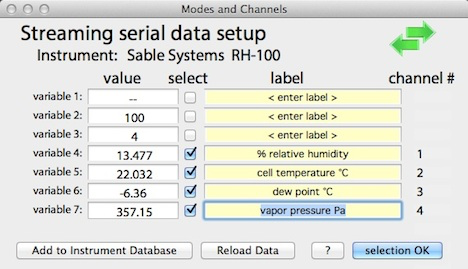|
A streaming
serial device (or serial stream, if you prefer) sends a periodically updated stream
of text-format data consisting of numeric variables (delimited by
commas), with each batch of data concluded with a carriage return
character. There may be one or more non-numeric text variables as well. Selecting this option opens the window shown below,in which you can select which of the variables in a 'stream' to use. Variables are shown in the 'value'
column. Text blocks that do not convert into numbers (i.e., they
contain characters other than " + - . 0 1 2 3 4 5 6 7 8 9 ") are shown
as blank ('--').
 The program knows the parameters of a number of streaming serial-capable instruments (mainly those from Sable Systems), such as the Sable RH-100 relative humidity sensor in the example at right. For a 'known' instrument, appropriate variable labels are automatically inserted. If your instrument is not being read correctly, try clicking the Reload data button.
The program knows the parameters of a number of streaming serial-capable instruments (mainly those from Sable Systems), such as the Sable RH-100 relative humidity sensor in the example at right. For a 'known' instrument, appropriate variable labels are automatically inserted. If your instrument is not being read correctly, try clicking the Reload data button.
- If your instrument is not recognized by LabHelper, fill in the 'label' edit fields with appropriate information (variable names) and click the 'Add to Instrument Database' button. You will be asked for a name for the instrument in a small window, and then the name and channel labels will be appended to the instrument list. This is a small text-format file called 'serial instrument database.txt', which is internal to the LabHelper application.
- Channel
numbers are not selected in the usual way. Instead, click the 'select' check buttons to indicate which subset of the variables you want to record. When you
select a variable, the computer automatically gives it a channel
number.they are assigned according to the
order of selected variables in the sample string (shown in the rightmost column). Do not attempt to
adjust this in the Display
Setup
window or problems will ensue.
- Note
that responses to button clicks, etc. can be slow in this window,
since the software spends a lot of time reading and verifying the
serial data. Responses when gathering data can also be slow. For
example, to enter a marker, hold the key down until the marker
appears. Similarly, click and hold a toobar icon until you get the
response you want.
- In
this mode there is no 'handshaking:' the serial device is not controlled
by the computer (it's just 'listened to'). LabHelper uses a simple and occasionally imperfect check on each
sample string to make sure it is complete before it is accepted for
processing, but the update rate is pretty much entirely a property of
the serial instrument.
- You
can enter channel labels here, or later in the Conversions window or the Display
setup window.
- The program will use the last-received data from each instrument channel to generate and upper or lower limit for screen display, as shown in the the Display
setup window. These are arbitrarily set to ~1.2 times the current data value; you will likely want to change them before starting to acquire data.
Troubleshooting:
Serial connections are simple in principle but can be tricky in
practice. If you have problems, start by making sure the baud rate is correct (the default is 9600 baud).
|